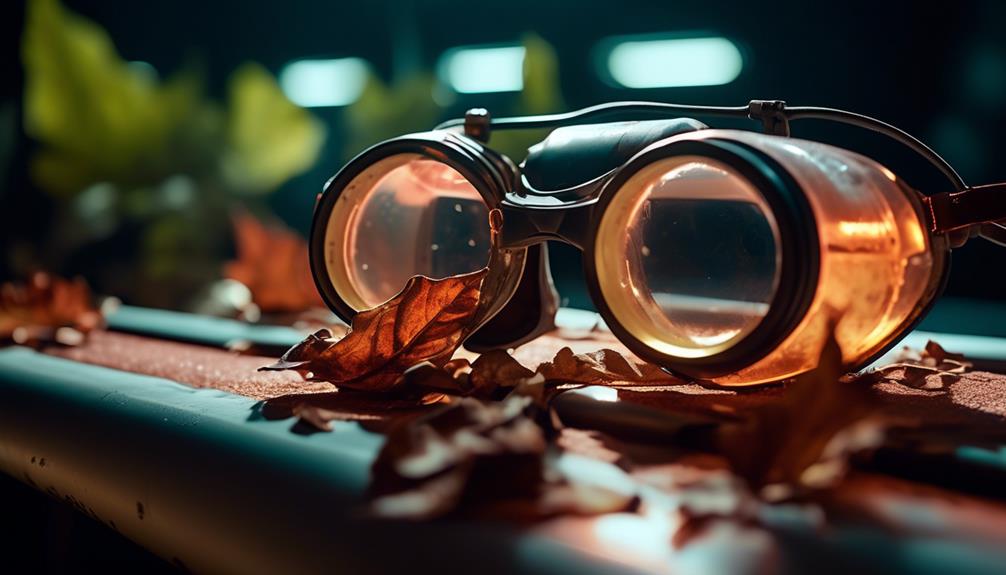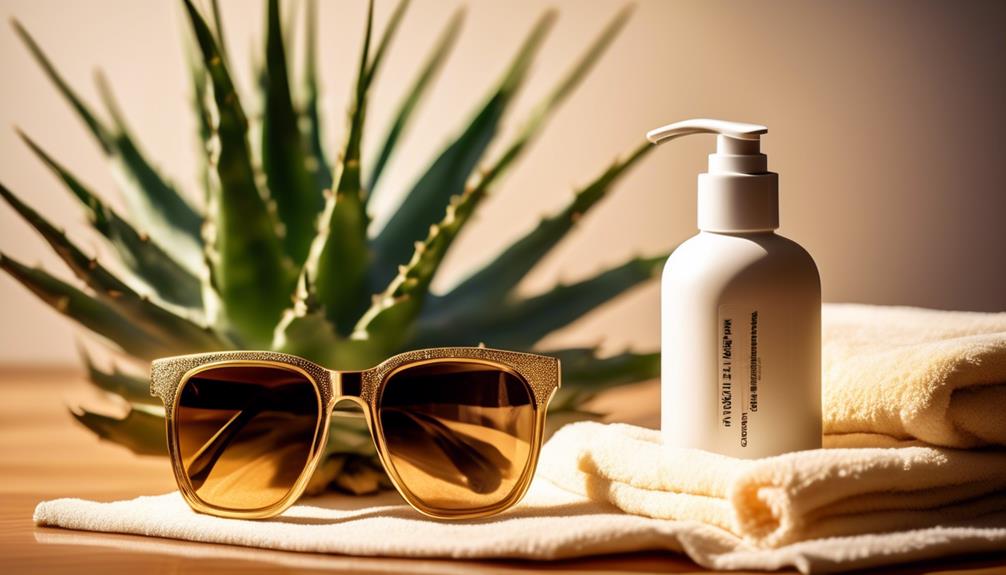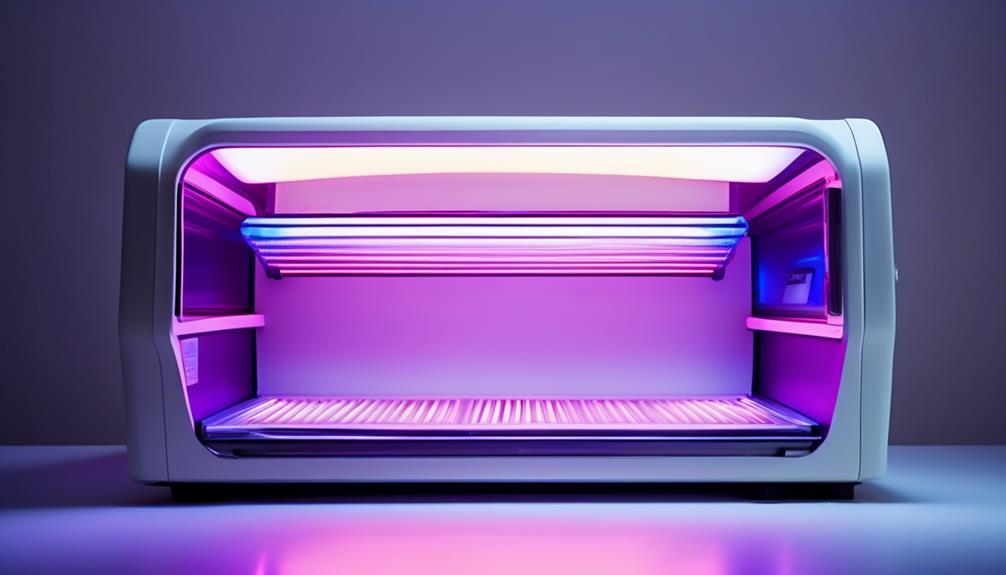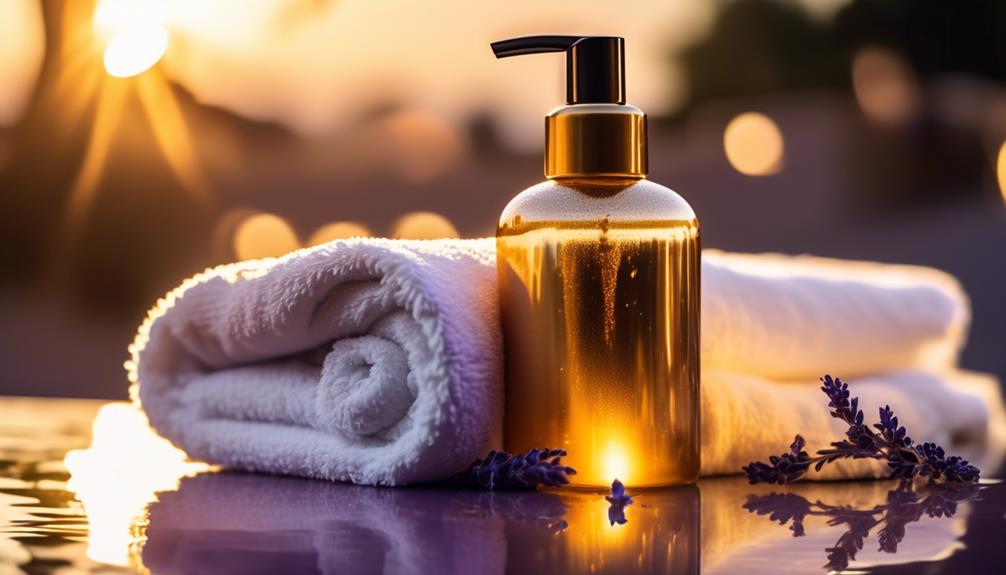You’ve probably heard the spiel on why moderation’s key, but let’s get real: your skin’s trying to tell you something when it starts acting up after those UV sessions. If you’re noticing your skin throwing a fit, turning redder than a lobster, or finding that your moles are doing some sketchy stuff, it’s time to pause and listen.
And sure, a golden tan might seem like the ultimate accessory, but trust me, the consequences can be as serious as skin text messages marked with a red flag. Stick around, and I’ll share the details about all the warning signs you should watch out for—because nobody’s got time for regrets, especially when it comes to your skin’s health.
Key Takeaways
- Unusual skin sensitivity, redness, itchiness, dryness, or peeling are signs of skin damage and overexposure to UV radiation.
- Tanning bed overuse increases the risk of developing long-term consequences such as actinic keratoses and melanoma.
- Itchy rashes and skin reactions are common after tanning bed sessions and ignoring these warning signs can lead to potential damage.
- Tanning bed overuse accelerates the skin’s aging process, leading to wrinkles, saggy skin, and uneven tone.
Unusual Skin Sensitivity
If your skin’s throwing a fit with redness or itchiness post-tan, it’s screaming for you to chill on the tanning bed sessions. This unusual skin sensitivity isn’t just a fluke—it’s a cry for help. After basking in those indoor tanning beds, if you’re feeling like a tender tomato or your skin’s itching like crazy, it’s time to step back.
This isn’t your typical ‘oops, got a little pink’ scenario; it’s your body waving red flags. When your skin’s more sensitive than your bestie watching a rom-com, it’s the UV radiation whispering, ‘I’ve done enough.’ Increased dryness, flakiness, or that oh-so-not-cute peeling—even when you’ve slathered on the moisturizer? Yeah, that’s your skin’s way of saying, ‘I’m over this.’ And let’s not even talk about those uninvited rashes, hives, or bumps making an appearance. They’re not just annoying; they’re warning signs.
Indulging in those tanning bed sessions might seem like self-care at first, but it increases your risk of some real damage. Tanning bed overuse isn’t just about the immediate burn; it’s a long-term relationship with your skin—and right now, yours is saying, ‘It’s not me, it’s definitely you.’
Persistent Redness
While unusual skin sensitivity is your complexion’s first SOS, persistent redness is like the alarm bells going off, signaling it’s time to really listen to what your skin is telling you about those tanning bed marathons. That stubborn flush isn’t just a temporary blush; it’s a cry for help from your overworked skin.
When your skin stays red long after those tanning sessions, it’s basically screaming, “we’ve got a problem!” This isn’t just about dodging a sunburn; it’s about stopping skin damage that can lead to premature aging and, scarier still, an increased risk of skin cancer.
And let’s get real, those bronze goals aren’t worth the cost of actinic keratoses – those rough, scaly patches that shout damage from exposure to UV rays. Even more alarming, using tanning beds before age 35 boosts your risk of melanoma by a whopping 75%. So next time your skin flares up, it’s begging you to reconsider that indoor tanning obsession.
Here’s a quick cheat sheet on what to watch out for:
| Warning Sign | Why It’s Bad News |
|---|---|
| Persistent Redness | Your skin’s in distress, and it could point to serious skin damage. |
| Doesn’t Fade | Lingering redness hints at deeper issues like premature aging. |
| UV Exposure | Each session piles on more UV radiation, raising cancer risks. |
| Actinic Keratoses | Rough spots may form, warning of pre-cancerous changes. |
| Tanning Beds Before Age 35 | You’re gambling with a massively increased risk of skin cancer. |
Your skin’s health is priceless. Don’t let those UV rays steal its glow.
Itchiness or Rash Development
If you’re rocking a not-so-chic itchy rash after your tanning bed session, it’s your skin shouting ‘too much!’
We’re about to break down why your skin’s freaking out and how you might be triggering those annoying rashes.
Plus, we’ll throw in some no-sweat tips to keep your skin smooth and rash-free, because who needs that itch cramping their style?
Identifying Skin Irritation
You might want to sit up and take notice if your skin starts itching or breaking out in a rash after those tanning bed sessions—it’s a classic red flag for overdoing it. Those UV rays aren’t just cozy warmth; they can be harsh on your skin cells.
Here’s some important points:
- Persistent Itchiness: Not just a fluke, it’s your skin crying out for a break.
- Rashy Reality: If you’re sporting a new patchwork of irritation, it’s time to step away.
- Protect Yo’ Self: Always wear protective gear. Goggles aren’t just a fashion statement—they’re a necessity.
- Cancer Caution: Don’t brush off these signs of skin trouble. You’re upping your risk of developing skin cancer with every extra session.
Stay safe and love your skin—it’s the only outfit you wear every day.
Causes of Tanning Rashes
Excessive UV exposure is the main culprit behind those pesky tanning rashes and non-stop itchiness. You’ve got to understand that those rays used in tanning beds are no joke. They’re like, super intense, and they don’t just magically give you that sun-kissed look—they can also mess with your skin big time.
Here’s a quick breakdown:
| Cause | Effect |
|---|---|
| Overexposure to UV | Itchiness & Redness |
| Repeated indoor tanning | Increased risk of rashes |
| Ignoring skin’s warning signs | Potential skin damage |
| Unprotected sunbathing | Higher risk of developing skin cancer |
Preventing Itchy Skin
To dodge that annoying itch and rash, it’s key to play it smart with your tanning routine—less is definitely more. Overdoing it in the tanning bed can really mess with your skin’s health, so let’s keep it cute and comfy, alright?
Here’s how you can keep itchy skin at bay and stay fab:
- Hydrate Like It’s Your Job: Slather on that moisturizer to keep your skin supple.
- Timing is Everything: Limit your UV exposure—short and sweet does the trick.
- Barrier Up: Use a barrier cream, especially on sensitive areas, to shield your skin.
- Aftercare is Self-Care: Post-tanning, treat your skin to some soothing aloe or a gentle, cooling lotion.
Accelerated Skin Aging
Basking in the glow of a tanning bed too often can fast-track your skin’s aging process, leaving you with wrinkles and saggy skin way before your time. You’re not just getting an indoor tan; you’re signing up for a future where your skin tells a tale of too much UV love. The risks of indoor tanning are no joke.
Those harmful UV rays you’re soaking up? They’re breaking down your precious collagen and elastin, the stuff that keeps your skin firm and bouncy. Prolonged exposure to UV light, especially the sinister UVB radiation, can leave your skin looking like an old leather bag – and not the chic vintage kind.
Here’s a quick breakdown to keep you in the know:
| Skin Sitch | UV Culprit | Aging Alert |
|---|---|---|
| Wrinkles | UV Light | Too Soon |
| Saggy Skin | UVB Radiation | Tightness, be gone |
| Uneven Tone | Harmful UV Rays | Dullness sets in |
Changes in Mole Appearance
Keep an eye on your moles, ’cause a change in their look could be shouting ‘trouble ahead’ when you’re overdoing it with the tanning beds. Those UV rays aren’t just for getting that golden glow—they’re famous for upping your chances of some pretty serious skin cancers. And , we’re not just talking about a possible tan line redo; it’s about spotting those warning signs early.
Moles can be like little billboards for your health, and when they start looking funky, it’s your cue to take action.
Check out these key changes that scream, ‘Get me to a doc, stat!’:
- Color Chameleon: Moles that switch up their shade or go dark-side could be hinting at basal cell carcinoma or squamous cell carcinoma.
- Border Patrol: If the edges are looking blurry or jagged, that’s not just quirky—it’s a red flag.
- Size Matters: A mole that’s growing faster than your follower count? Yeah, that’s not normal.
- Feel the Burn: Itchy, tender, or bleeding moles are crying out for attention.
Excessive Dryness or Peeling
When your skin starts acting like a snake shedding its skin too often, it’s a pretty clear shoutout that you might be hitting the tanning bed too hard. Listen, nobody’s saying you can’t chase that golden glow, but let’s keep it real – your skin’s throwing up red flags like it’s in a parade.
Excessive dryness or peeling isn’t just a minor oopsie; it’s your body telling you that the UV rays used in tanning beds are doing a number on your skin.
If you’ve been cozying up with the indoor tan a bit much, you might notice your skin feels like parchment paper. Not only does this crank up the developing risk of skin drama, but it also can make you look like you’ve fast-forwarded a few years in the aging department – and not in a fine wine kind of way.
The Food and Drug Administration (FDA) isn’t just whistling Dixie when they warn about tanning salons. Overdoing it can increase your sensitivity to sunlight, which is the opposite of chill. So, if you use a tanning bed and your skin’s peeling like it’s auditioning for a horror flick, it’s time to take a beat and show your skin some much-needed TLC.
Development of New Skin Spots
Amidst the quest for that sun-kissed bronze, spotting new freckles or moles on your skin can be a major red flag signaling you’ve overdone the UV rays in the tanning bed. Listen, your skin’s telling you something when these newbies pop up—it’s not happy!
These seemingly innocent marks might be more than just beauty spots; they could be signs that you’re cranking up your risk of developing skin issues.
Here’s some tips on what to watch for:
- New kids on the block: Any fresh spots or dots that weren’t there before your latest indoor tan session? Red alert.
- Oddballs: Spots that look kinda funky, with weird shapes or colors? Get them checked out, pronto.
- Change isn’t always good: Moles that have decided to switch up their look—bigger, badder, or just different—need a pro’s eye.
- Rapid growers: A spot that’s growing faster than your desire for that next tan? It’s waving a danger flag.
Sure, we all love looking like we’ve just returned from a vacay in the tropics, but remember, even an indoor tan can increase the risk of basal and other dangerous forms of skin drama.
Eye Irritation and Discomfort
If your peepers are feeling gritty or looking a bit red after a tanning sesh, you might be overdoing it with the UV rays.
Don’t brush it off – that discomfort can be a red flag for some serious eye damage down the line.
Always rock some cool protective goggles to fend off those nasty rays and keep your eye game strong.
UV-Induced Eye Damage
Exposing your eyes to UV rays from tanning beds can seriously irritate them and even lead to long-term damage. One such damage is photokeratitis, which is basically a nasty sunburn on your cornea. Photokeratitis feels like you’ve rubbed sand in your eyes, and it’s not a good look or feeling.
In addition to photokeratitis, there are other risks involved. UV exposure can increase the risk of cataracts, which can cause blurry vision and seriously cramp your style. It can also contribute to macular degeneration, which can mess with your central vision – something you definitely want to avoid.
Moreover, there is a cancer risk associated with UV radiation from tanning beds. The World Health Organization has issued warning labels, highlighting that UV radiation can increase the risk of skin cancer around the eyes.
Considering all these risks, it’s important to question why anyone would risk their peepers by exposing them to UV rays from tanning beds.
Preventing Tanning Goggle Marks
While you’re keeping those peepers safe from UV damage, don’t forget that sporting tanning goggles can leave you with less-than-chic marks; let’s talk about nixing those pesky lines.
Snag eyewear made for the glow-up game. Ensure it fits like a dream—not too snug, okay? No one’s here for the squeeze play on your precious skin. If your indoor tan sesh has built-in eye shields, even better. More chill, less grill for your eyes!
Now drape a towel over those baby blues to dodge direct light, ’cause comfort is queen.
And please, leave the lotions for later—slicking up near your eyes is a no-go if you’re not into goggle tracks.
Remember, we’re all about protecting that skin—wear sunscreen and prevent sunburn without compromising on style.
Stay safe, look fierce, and reduce that risk of skin cancer.
Frequently Asked Questions
What Are the Effects of Too Much Sunbeds?
You’re playing with fire using sunbeds too much. They can seriously mess with your skin, aging you prematurely with wrinkles and dark spots.
You’re not just going for a golden glow; you’re risking skin cancer, including deadly melanoma. Trust me, you don’t want to gamble with your skin’s health for a tan.
There are safer ways to get that sun-kissed look without putting your life on the line.
What Happens if You Stay in a Tanning Bed Too Long?
If you overdo it in a tanning bed, you’re risking serious burns. It’s not just about looking like a sun-kissed goddess; you could seriously damage your skin.
You might feel super sore, see your skin peeling, or even get blisters. Trust me, it’s not worth it. Better to take it slow and steady, and keep that skin looking fierce without the ouch factor.
Stay safe and slay responsibly!
What Happens if You Tan Too Often?
Did you know tanning before 35 boosts melanoma risk by 75%? If you’re hitting the tanning bed too often, you’re playing with fire.
Your skin’s begging for a break, showing wrinkles and spots way too soon. Plus, that bronzed glow? It’s a facade that could cost you big time, health-wise.
Cut back now, and your skin will thank you with some real love in the long run.
Which Health Risk Is Associated With Tanning Beds?
You’re risking a lot with those tanning bed sessions.
They’re not just a shortcut to glowing skin – they’re a quick path to serious health issues like skin cancer. You’re upping your chances of basal cell carcinoma, squamous cell carcinoma, and the deadliest, melanoma.
Plus, you’re not doing your immune system any favors. Let’s keep it real, vitamin D’s got better sources than a UV bed.
Stay safe, skip the bake.




